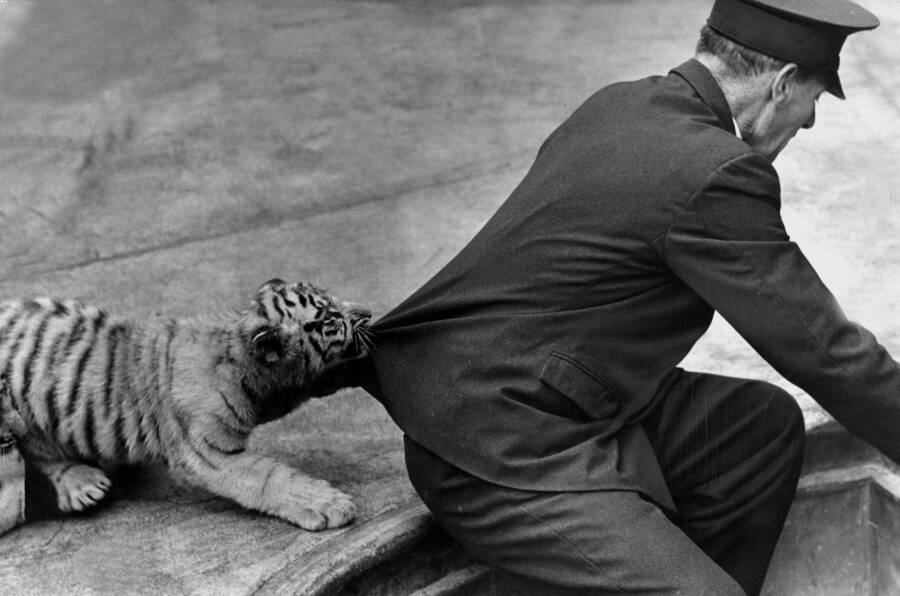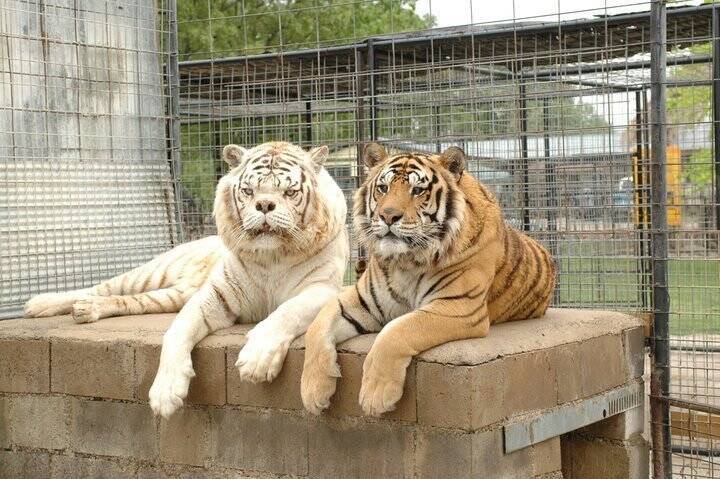A white tiger believed to have Down syndrome, Kenny went viral online as the so-called "ugliest tiger in the world" — but the truth was much more heartbreaking.

Turpentine Creek Wildlife Refuge/FacebookKenny was a white tiger rescued from an Arkansas breeder alongside his parents and brother, all of whom were living in filthy cages littered with feces and dead chickens.
Since the 2000s, photos of Kenny the “tiger with Down syndrome” have made him an online sensation. Countless people have been captivated by his story, in which “the world’s ugliest tiger” was rescued from an abusive breeder who determined that he was “too ugly” to sell. Both his story and his appearance garnered enormous amounts of sympathy online — and Kenny wasn’t alone.
Untold numbers of stories about animals with Down syndrome have made their way around the internet, thanks to Facebook, Instagram, Twitter, and YouTube, where short “documentaries” chronicle these animals’ difficult lives.
However, all of these stories are false. In fact, most animals, felines especially, aren’t able to develop Down syndrome — and that includes Kenny.
So, what’s Kenny the tiger’s real story?
The Myth Of “Endangered” White Tigers And The Breeding Practices Responsible For Them
Many breeders, entertainers, and even some zoos that feature white tigers like to tell the same story: These tigers are endangered, and conservation efforts must be made to ensure their survival. The average person would have no reason to doubt this claim, of course. After all, nature is rife with animals like brown bears and black bears and red pandas — why should white tigers be any different?
Well, as Susan Bass of the Florida-based sanctuary Big Cat Rescue (BCR) told The Dodo, “White tigers are not a species, they’re not endangered, they’re not in the wild. There are so many misconceptions about white tigers.”

Seng Chye Teo/Getty ImagesA pair of white tigers, who all share a propensity for certain genetic mutations as they all descend from the same original white tiger.
In fact, Bass said, there hasn’t been a sighting of a wild white tiger since the 1950s. That tiger was a cub living with a family of standard, orange tigers, but the person who found them was so intrigued by the light variation of the cub’s coat that they stole it away from its mother and siblings.
White tigers today all descend from that cub, whose coat was the result of a double-recessive gene combination.
So, while white tigers are undeniably beautiful, there is only one way, really, that breeders can achieve that double-recessive gene combination: breeding tigers “over and over again to get that gene to come forward,” Bass explained.
Of course, that doesn’t mean breeding just any two tigers — they all still trace back to that original white tiger, meaning most white tigers are the result of generations of inbreeding, which can cause any number of health and physical complications. Kenny, whose parents were siblings, is just one example of what the end result of this inbreeding can be.
Bass continued, saying that most white tigers are cross-eyed, even if it may not be apparent when you look at them. Their optic nerves, however, are often crossed. In addition, “They don’t live as long. They have kidney problems, they have spine issues.” One white tiger at BCR, like many others, has a cleft palate that makes it “look like she’s always smiling.”
But the cruel treatment of white tigers doesn’t start and end with inbreeding and physical deformities. The main appeal of these animals, for breeders at least, is that people are willing to pay money to see them — and they’ve been a staple of Las Vegas entertainment for decades.

Tibbles Maurice/Daily Mirror/Mirrorpix via Getty ImagesAkbar, a white tiger cub with Bristol Zoo senior keeper Bill Barrett in October 1968.
Of course, people might be less willing to pay money if they knew the truth, which would be apparent if they were presented with a physically deformed white tiger, meaning only “ideal” tigers are sold.
“To get that one perfect, pretty white cub, it’s one out of 30,” Bass said. “What happens to the other 29 … euthanized, abandoned … who knows.”
Kenny was one of the rare cases where a physically deformed white tiger happened to make it into the public eye, but his situation beforehand was a far cry from ideal.
How Kenny The Tiger’s Infamy Exposed The Breeding Industry
In 2000, Kenny was rescued by the Turpentine Creek Wildlife Refuge, taken from the tiger farm in Bentonville, Arkansas, where he was born in 1998. According to a report from The Mirror, Kenny lived there in filth for the first two years of his life — and was nearly killed at birth.

Turpentine Creek Wildlife Refuge/FacebookKenny and his brother Willie, an orange, cross-eyed tiger rescued from the same breeder.
Kenny was one of two cubs in his litter to survive. The other, his brother Willie, was born orange and severely cross-eyed. The rest of the cubs were stillborn or died at birth. Their parents were brother and sister.
The breeder claimed that Kenny’s facial deformities were a result of the cub smashing his face into a wall repeatedly. He also admitted that he would have simply killed the cub at birth had his son not felt that Kenny was “too cute.”
White tiger traffickers were once able to sell “ideal” cubs for over $36,000. At the time of The Mirror’s report in 2019, that price had dropped to around $4,000.
When the Arkansas breeder contacted Turpentine Creek Wildlife Refuge in 2000, realizing he wouldn’t make a profit from his inbred tiger family, they found the tigers in cages riddled with feces and dead chicken remains. The “gruff man” still demanded nearly $8,000 for them. When they refused, he handed over the tigers for free.
“The gentleman that we rescued [Kenny] from said he would constantly run his face into the wall,” said Emily McCormack, animal curator for Turpentine Creek. “But it was clear that that wasn’t the situation.”
Photos of Kenny then went viral alongside inaccurate claims that he had Down syndrome, but McCormack noted that, mentally, Kenny was no different than any other tiger.

Turpentine Creek Wildlife Refuge/FacebookThough most tigers in captivity can live to be older than 20, Kenny died at only 10 years old after a battle with melanoma.
“He acted like the rest of them,” she said. “He loved enrichment, he had a favorite toy … he ran around in his habitat, he ate grass, he just looked kind of silly.”
Unfortunately, Kenny died in 2008 after a battle with melanoma, a serious type of skin cancer that develops in cells that produce melanin, the pigment that gives skin its color. He was 10 years old, under half the average age of a tiger in captivity.
The Exploitative Breeding Practices Continue After Kenny The Tiger’s Demise
Members of Turpentine Creek Wildlife Refuge were later interviewed for an episode of ABC’s 20/20 focused on the magicians Siegfried and Roy, who were known to use a variety of exotic animals in their act — including white tigers. Their show came to an end when Roy was nearly killed by one of their white tigers, Mantacore.
“When Emily McCormack and Tanya Smith were interviewed, we were informed the second half of the 20/20 ‘Siegfried and Roy’ special would show the other side of magic shows,” a 2019 post from the sanctuary reads. “Sadly, the two-hour special seemed to be a very long promotion for Siegfried and Roy’s upcoming biography movie.”
20/20 correspondent Deborah Roberts also defended Siegfried and Roy’s tiger-breeding, saying, “There have been no reports of abnormalities with Siegfried and Roy’s white tigers. In fact, they say they practice conscientious breeding to avoid mating tigers that are closely related, and they say they stopped breeding tigers back in 2015.”
Of course, Turpentine Creek Wildlife Refuge once again acknowledged that it is factually impossible to “conscientiously” breed white tigers, as they are all related, and they all share the same “faulty genetics and predisposition for a number of diseases and deformities.”

Getty ImagesSiegfried and Roy circa 1990 with one of their white tigers, a prominent part of their magic act.
That same year, The Mirror reported that there had been an increase in the slaughter of white tigers for their fur and meat, with their skins being turned into rugs, their bones being used in healing tonics and wine, and their meat sold to restaurants or used in stock cubes.
This would be alarming no matter the animal, but it is especially troubling with white tigers as it encourages illegal farms to continue their unethical breeding practices.
As Bass said, “These are not a species, they are not endangered, they don’t need to be saved, they shouldn’t exist. [Breeders and owners are] duping the public into thinking that they need conservation, and paying money to see them.”
After discovering the truth about white tiger breeding and Kenny the white tiger, learn about “Tiger King” Joe Exotic. Then, read the true story of Doc Antle’s cult-like animal sanctuary that was featured in Tiger King.





